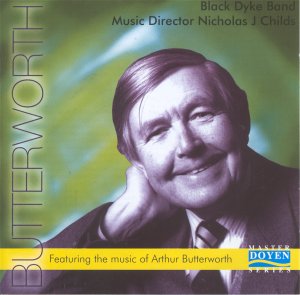This is the first Arthur Butterworth CD to be issued
since 1998 when ClassicO paired the First Symphony with Ruth Gipps'
second. This is also the first all-Butterworth CD ever to be issued.
The composer is one of the UK's most masterly, writing potently atmospheric
and memorably lyrical music which even now receives hardly any attention.
His four orchestral symphonies (1957, 1965, 1979, 1986, 2002) should
have been recorded years ago. They are every bit as compelling as the
five by Alwyn and the nine by Arnold: dour, gripping, Northern and confident.
There is also an Odin symphony for brass which really ought to
have been here, if necessary in place of the Handel transcription. Perhaps
it is being reserved for a second Butterworth volume with the Caliban
scherzo. In any event Odin was written for the Black Dyke folk
so we really should hear it from them especially if they are in the
sort of superb form in which we hear them in this sequence.
The two Brahms connected works are in one case a highly
skilled transcription (the Handel Variations and Fugue)
and in the other (the Passacaglia) a brilliant free set
of variations on material from the finale of Brahms' Fourth Symphony.
No doubt these works were prompted by Butterworth's time as trumpet
player with the Scottish National Orchestra and from 1955 to 1962 with
Barbirolli in the Hallé. Both works are full of exciting detailing
and not a moment of the sort of dullness that you might, in your worst
moments, associate with Brahms. Butterworth's and Childs' work here
banish fears of congested and curdled textures.
The Three Impressions are grim landscapes
rather like the Arnold Cornish Dances shorn of levity. Dark satanic
mills glower and spew out smoke. This is a Victorian England of hideous
engines and the subjugation of men to the industrial imperative. Alan
Bush would have warmed to this music. The music has something of the
lamentation of Holst's Egdon Heath and the black energy of Saturn
and of Vaughan Williams' Sixth and Seventh Symphonies.
The Sinfonia Concertante is in four movements
with the last two linked. It is more symphony, with solo roles for the
tenor and the baritone horns, than a concerto. This is once again instinct
with disturbing energy and brooding - the voices are from Sibelius's
Fourth Symphony and a little from Prokofiev, The tolling bells and menace
of the Night Music movement take us again close to Arnold's haunted
mine wheelhouses.
Butterworth writes powerful and accessible music full
of inventive coups, rippling galvanic energy and rough-hewn drama. Hearing
both the Impressions and the Sinfonia makes me lament
all the more the absence from this disc of the Odin symphony.
Childs and the band are in award-winning form here
with crisp playing, smashing impact and splendid address throughout
the range from sopranino to bass.
The helpful and detailed liner notes are by Paul Conway
who has done so much to document the history of the symphony in Britain
in the Twentieth Century. Doyen did well to commission this piece from
him.
A smashingly virtuosic disc with a Brahmsian emphasis
in two works neatly offset by a Nordic clarity and volcanic energy in
the Sinfonia and Impressions.
Rob Barnett
see also review
by Chris Thomas
